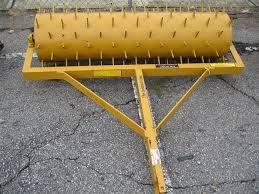Aerating Pastures: Is It Worth It?
 Cattle producers in Kentucky rely on cool-season perennial grasses to provide the majority of forage for their cattle operations. Grasses, such as tall fescue, can be grazed for many years without any type of tillage tool being used on the field. Concerns exist that traffic from cattle and machinery in pastures and hayfields may result in soil compaction, which could limit water infiltration and result in reduced forage yields.
Cattle producers in Kentucky rely on cool-season perennial grasses to provide the majority of forage for their cattle operations. Grasses, such as tall fescue, can be grazed for many years without any type of tillage tool being used on the field. Concerns exist that traffic from cattle and machinery in pastures and hayfields may result in soil compaction, which could limit water infiltration and result in reduced forage yields.
Over the last several years, many claims have been made which suggest substantial increases in forage yields after aeration of pastures or hayfields. Aerator machines are tractor-drawn with varying designs, such as coulters making a narrow slit in the soil, a roller with many spikes making indentations in the soil, or prongs which function like a mini-subsoiler. Aerators are designed to disrupt the soil and loosen any soil compaction in the upper soil surface, allowing water to infiltrate the soil rather than run off.
The University of Tennessee has conducted experiments at both the Spring Hill and Knoxville experiment stations on fields with tall fescue. Each experiment received 60 pounds of nitrogen/acre during spring green up, and the same type of harvesting equipment was used at each location. The comparison between these two sites were performed over a two year period. A common spike aerator was pulled across the field each spring at both locations, and an additional aeration treatment at Spring Hill in the fall each year. These experiments showed no difference in forage yield between aerated and non-aerated areas.
Additional on-farm demonstrations with aerated and non-aerated strips of tall fescue on four farms in south central Tennessee revealed aeration only provided a forage yield advantage of 214 pounds of dry forage per acre. The cost of aeration was estimated at approximately $10 per acre, and it was concluded that aeration did not cover the additional expense.
Most of the research conducted on the value of aerators for pasture and hay is not encouraging. This does not mean that aeration will always be ineffective. The possibility exists for aeration equipment to improve water infiltration and increase forage yield where there is severe compaction problems from cattle trampling or heavy equipment traffic.
Information regarding the University of Tennessee research.
Categories:
Spring
Establishment/Renovation


